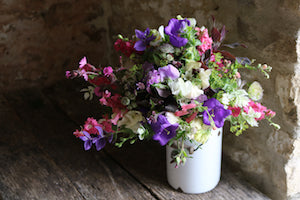Tips for autumn sowing of hardy annuals

Planning ahead for the next season is an activity which occupies a great deal of my time. While I'm always happy to see our garden in full flower, it is what's coming next which is what really interests me. And at this time of year (late August,) my thoughts begin to turn to spring, and what we can get ahead with to make sure we have a good early crop of flowers for our customers next season.
First I look at our leftover seed from this year. We buy seed fresh every year, and successionally sow it in batches. Our September sowing will hopefully use up all our leftovers so that we then order fresh for sowing next year.
I'll be looking for varieties like ammi majus, clary sage, orlaya grandiflora, nigella, calendula, dill, larkspur, Californian poppy, cornflowers, lavatera, ammi visnaga, cerinthe, and sweet peas: hardy hardy annuals which will happily germinate now, even though light levels are diminishing, and then will spend the winter growing nice deep root systems, and then flower in late spring next year.
We'll sow our seed in seed trays in small quantities: remember, nobody, not even flower farmers like us, needs hundreds of plants of ammi majus flowering at once. We might sow thirty five ammi majus seeds, you might sow five or six. One autumn-sown ammi majus plant in full flower might be six foot high and three feet across so do be mindful how much space you'll have to fill eventually in the ground, and don't over-sow!
We use very fine and expensive seed compost because we like to give our little germinating plants the very best start in life: I call this the cashmere blanket of seed compost. We like Sylvagrow best.
Once the seed is sown we'll water well from underneath - i.e. we put the trays of seeds to germinate in trays of water so that the compost can absorb as much water as necessary from underneath until it's absorbed enough. We never water germinating seeds or seedlings from above because a) it's like watering with a tidal wave and you risk losing half your seeds by washing them over the edge of the seed tray, and b) very wet surface of seed compost encourages damping off, and I don't want my seedlings to rot so that I lose them.
I sow very few seeds per module in a seed tray so that I don't have to prick out or pot on, but I do plant my seedlings out into my tunnel in October where they'll over winter. You might want to prick out your seedlings when they're about three weeks old into a small pot each where they can grow a good sized root ball over winter and be ready to plant out (with fleece protecion) sometime in March.
Choose seeds which will mix well with your perennial garden flowers, like roses and peonies, so lacy ammi, daisy like feverfew, beautiful spiked larkspur, and the cheerful buttons of cornflowers make good mixers.
Don't sow too much! You won't have room for them all (though we'll be glad of your spares at our plant sale in aid of the restoration of our village church which is in the calendar for the first Saturday in May 2019.)
For more on growing a cut flower patch, come on our workshp ... see link below.








